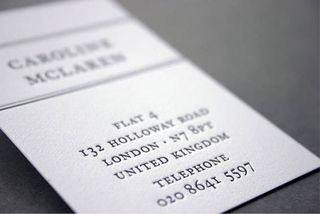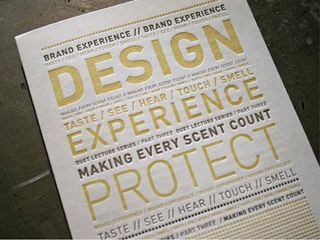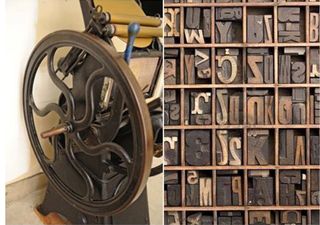Beginner's guide to letterpress - plus 5 pro tips
Why a 15th century printing technique has become so popular today, plus some handy tips on using it yourself.
Letterpress was invented in the 15th century and was the first reliable and widely used method of printing. A laborious but ultimately rewarding process, letterpress printing involves manually arranging words and designs before pressing them into high-quality paper.
Letterpress was later joined by modern lithographic printing, which is used more often when producing large volumes of print, such as newspapers, magazines and books. In recent years, letterpress has seen a resurgence in design circles, gaining popularity when printing simple designs and typographical pieces such as business cards, as a unique, textured variant to digital print.
So read on to find out more about letterpress, and at the end we have 5 top tips for you. Then why not look up some great letterpress printing resources to take your interest further?
Letterpress is tactile
Letterpress is attractive to graphic designers for a number of reasons. One of the main reasons is the tactile nature of the work produced using letterpress. These pieces feature a slightly embossed effect which makes the work more tangible and interesting.
To get the full effect, most printers will use a heavyweight, high-quality paper stock as well. This gives the work more value by not only adding to the cost to the designer, but also by making the design look and feel more expensive, with a traditional feel that is becoming increasingly popular in recent years.
It makes your work stand out

Many designers are feeling the pressure to put out work which has a unique slant to it. With so many designers and artists out there, and each having their own platform thanks to social networking sites and online stores, a designer looking to make an impact needs to find a Unique Selling Point (USP).
When it comes to buyers, they are looking at 'why' they should spend money on designs, and those selling their work need to find a USP which separates them from other designers. To find this, designers need to ask themselves a series of questions about what they do and why they do it, such as:
Get the Creative Bloq Newsletter
Daily design news, reviews, how-tos and more, as picked by the editors.
- What do I do? How can my work be described?
- Do I have any specialities?
- What expertise do I have that is different from the rest?
Letterpress may be listed for any of these questions, providing an almost 'built-in' USP.
When it comes to selling work, digital marketplaces are saturated with designers, but do still provide an easy place to start selling for those new to the industry. This is because there are so many different outlets which allow people to sell their work for free, including sites like Etsy, Ebay, Amazon, Zazzle and Folksy.
Social media is already embedded into the digital marketplace, which allows designers to advertise work and explain to people why it is unique and worth buying, on the same platform that it is sold.
It's ideal for custom items

Because of the innovations in technology, so much of what consumers buy is mass-produced by printing companies. This means that there is a great desire for custom items.
Not only are those working with letterpress making only very short-run prints, in many cases these can be customised to fit the individual. Stores such as Etsy or Folksy are great resources for those searching for letterpress items, and many of these sellers will be happy to create custom items.
Regardless of the price, a custom item seems better thought-out and more personal to the individual receiving it, than something that has been run off in a factory as one of thousands. As gifts, custom items make the giver seem more thoughtful, having given something that relates directly to the recipient, even if the giver has only had to tell the designer the name or details of the recipient.
Custom items are ideal for special events such as birthdays, weddings and anniversaries, as these are occasions that people want to remember and have mementos of. Invites are unlikely to be printed with the invitees name on using letterpress, as this requires numerous plates to be made to order. However, gifts for the bride and groom, or birthday girl/boy are ideal in this medium.
It feels more 'real'

Many people feel that something printed using letterpress is more 'real' than lithographic printing. Letterpress creates a more solid piece of work which customers can tell a lot of work and time has gone into.
When people are spending money on designs they want to feel that they are buying something that is worth their money. It is worth bearing in mind that newer letterpress machines use polymer plates, which make the process both easier to learn and undertake, but this should not undermine the value of the work produced and will still impress the potential buyer.
Tips for letterpress design

For designers looking to get into letterpress, there are a few things that should be taken into consideration when putting together a design.
- Use lines of at least .25 to ensure that they show up after printing. Letterpress is a more advanced process these days, which means it can print thinner lines more effectively, but avoiding hairlines ensures that the printed design will look perfect.
- Letterpress printing traditionally uses up to two spot colours and will be more expensive if more colours are used. Designers are free to use up to four colours in their design, but it is expensive and may not be necessary.
- One of the strengths of letterpress is its ability to print colours at 100%. For lighter colours, designers should use a separate, lighter coloured ink rather than a screen. Screens work better with offset printing.
- Letterpress is ideal for printing type but designers should aim to keep font sizes to larger than 6pt to get the very best result.
- Crop marks should be used during the design process to ensure that the whole design comes out during printing. This is recommended for most types of printing, as designs created up to the trim line have a tendency to be cut awkwardly.
Words: Shout Digital
Shout Digital is a full service digital agency, headquartered in Newcastle upon Tyne, working for clients including Elanders UK.

Thank you for reading 5 articles this month* Join now for unlimited access
Enjoy your first month for just £1 / $1 / €1
*Read 5 free articles per month without a subscription

Join now for unlimited access
Try first month for just £1 / $1 / €1
The Creative Bloq team is made up of a group of design fans, and has changed and evolved since Creative Bloq began back in 2012. The current website team consists of eight full-time members of staff: Editor Georgia Coggan, Deputy Editor Rosie Hilder, Ecommerce Editor Beren Neale, Senior News Editor Daniel Piper, Editor, Digital Art and 3D Ian Dean, Tech Reviews Editor Erlingur Einarsson, Ecommerce Writer Beth Nicholls and Staff Writer Natalie Fear, as well as a roster of freelancers from around the world. The ImagineFX magazine team also pitch in, ensuring that content from leading digital art publication ImagineFX is represented on Creative Bloq.
